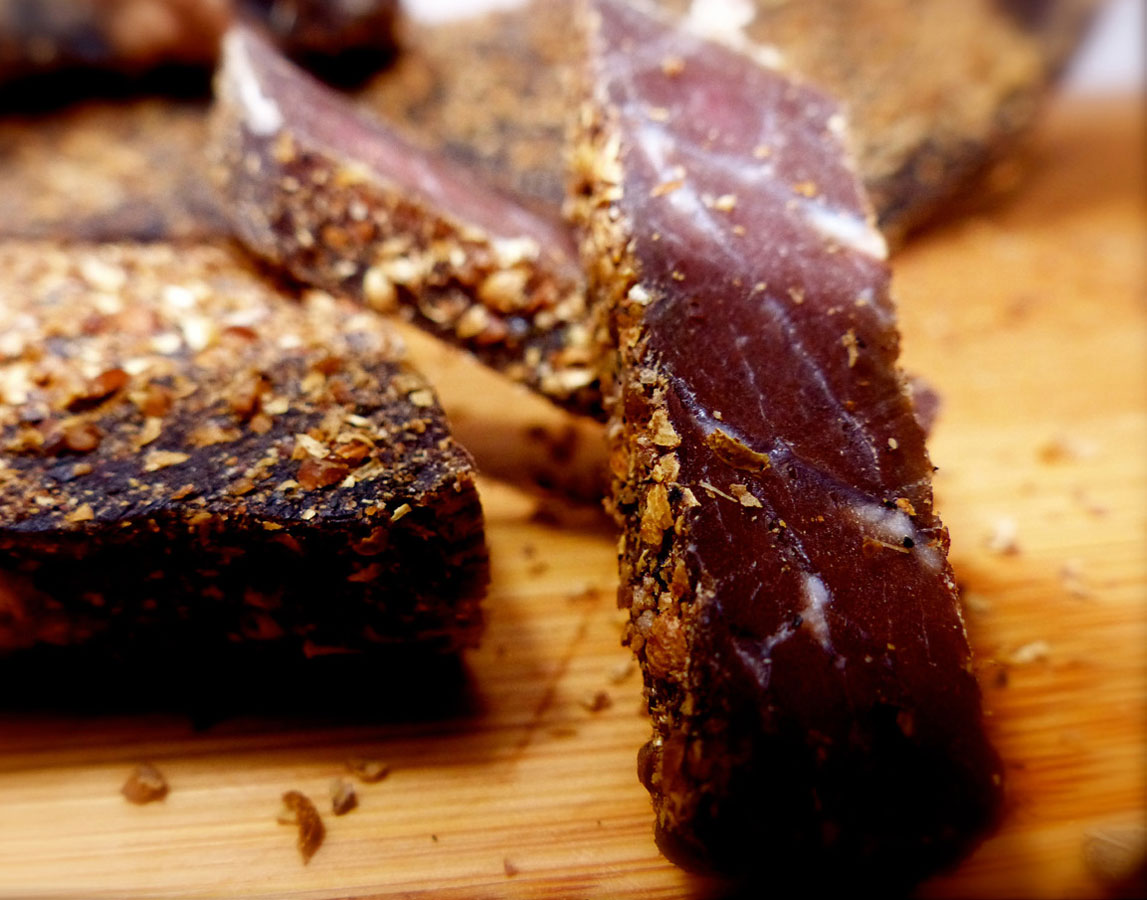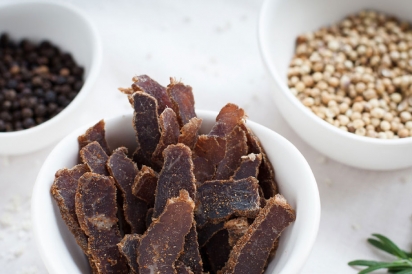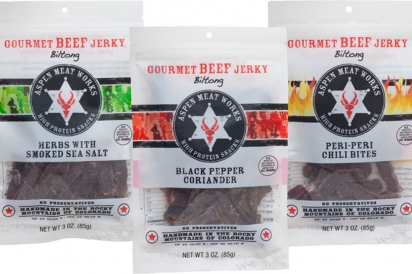Bilt to Last: Aspen Meat Works Puts Modern Twist on South African Superfood
bil·tong ‘bil,tôNG
noun / SOUTH AFRICAN
lean meat that is salted and dried in strips
Aspen may be an international destination but indigenous or traditional foods from other countries can be hard to find in our markets and restaurants.
Until recently, biltong was no exception. The Valley’s considerable South African contingent hoarded supplies of this humble air-dried seasoned meat in their cupboards and backpacks, bringing it back after trips home or even making it themselves when cravings got really bad. But finding it on the grocery store shelves? Good luck.
That all changed this past winter, when business partners and South Africa transplants Craig Hart and Christina Kruger capped three years of product development and business planning with the launch of Aspen Meat Works, a USDA-certified biltong company.
For South Africans, biltong is the ultimate comfort and subsistence food, a beloved snack with its roots in the cultures of both indigenous South Africans and the country’s European explorers and settlers. It’s traditionally made from either springbok (an antelope native to southwestern Africa), kudu (a larger species of antelope) or beef. Given the dearth of springbok and kudu in the Roaring Fork Valley, beef was an easy pick for Aspen Meat Works’ protein of choice (though their logo features a springbok head in tribute).
Finding a beef source that emphasized the company’s ethos of sustainability and humane livestock management was paramount, says Kruger.
“That was our main criterion, finding a consistent beef supply that was raised in a manner that met our green ethos.”
The company’s beef comes from humanely raised, grassfed cattle that are free of antibiotics and added hormones. Their diet makes for meat higher in omega-3 fatty acids and conjugated linoleic acids, which help promote heart health and lower cholesterol.
“People have a deeper level of understanding about where their food comes from these days,” says Hart. “They care more about its provenance and how it’s raised.”
Aspen Meat Works biltong comes in three flavors, including the traditional peri-peri or bird’s eye chile, a fragrant, fruity and hot-as-the-dickens little pepper. Peri-peri chiles first came to Africa via Portuguese explorers, but Dutch and other European settlers known as Afrikaners soon incorporated them into their diets. In Aspen Meat Works’ rendition of the flavor, USDA-certified peri-peri chiles are accented with onion, garlic, lemon peel and black pepper.
Another variety, the piquant Black Pepper Coriander biltong, also replicates a traditional South African flavor but elevates it with fragrant toasted coriander seed. The company’s Herbs with Smoked Sea Salt biltong is made with dried, organic Herbes de Provence (thyme, rosemary, marjoram, lavender), as well as coriander and black pepper.
While it may be a specialty food here, in South Africa biltong is sold everywhere from roadside stands to beach shacks. Some South Africans make their own, but for those in the Aspen area who don’t, Hart and Kruger hope Aspen Meat Works will offer a taste of home.
As Hart explains, Aspen’s South African contingent embraces the area’s active, outdoor lifestyle. “Culturally, [South Africans are] active, adventurous adrenalin junkies.”
Hart and Kruger count themselves among this group: Hart came to Aspen 21 years ago on a snowboarding vacation and wound up relocating here. The 42-year-old Cape Town native, also an avid mountain and dirt biker, kiteboarder and hiker, had been working in restaurants since he was 15. His passion for good food and local sourcing was further inspired by his current job as part-time manager of Cache Cache, where he’s worked for seven years.
Kruger, for her part, came to Aspen 16 years ago from her hometown of Pretoria to ski and paraglide. After staying for a summer, she fell in love with the Rocky Mountain lifestyle, and eventually married a South African who is an organic farmer and small-scale cattle rancher in Woody Creek.
To hear Hart and Kruger tell it, biltong is the ideal food for people like them—and endurance athletes in general. It may be a humble snack, but it fills a niche in an energy bar market overloaded with processed ingredients.
“Biltong is something most South Africans carry with them,” says Kruger. “Part of our goal is to introduce this high-protein snack and educate the public about it. Although it’s quite different from jerky in several key ways, we included the words ‘beef jerky’ on the label so [new] consumers have a reference point.”
Unlike most mass-produced jerky, which is fabricated from meat scraps and dried via low heat in an oven, smoker or dehydrator, all biltong is made from whole muscle meat and air-dried in a controlled environment. The absence of heat keeps the enzymes in the meat intact, “which makes it higher in protein than jerky,” explains Hart. “It’s also higher in nutrients like vitamins C and B, which are denatured during heat application.”
Aspen Meat Works starts with lean eye of round steak, which is cut into strips and marinated in spices, apple cider vinegar and salt. This brine acts as a preservative and helps inhibit harmful bacteria and spoilage. The meat is then placed in a climate-controlled room for aging to eliminate pathogens and ensure a shelf-stable, uncooked product.
After drying, the meat is cut into tender, bite-size pieces ideal for on-the-go snacking. The result is a USDA-certified, ready-to-eat and minimally processed food product, free of preservatives and artificial ingredients. Proclaims Hart proudly, “You can pronounce every single ingredient in our products.”
So far, the reception to Aspen Meat Works from friends, family and the community has been overwhelmingly positive, says Kruger. The company’s products should be available in Whole Foods’ stores throughout the Rocky Mountain region this spring.
“Everyone has been enthusiastic and supportive,” she says. “They’re happy to have a high-protein product on the market, without all the unnecessary crap in it!”
Adds Hart, who tried out early versions on Cache Cache Owner and Executive Chef Chris Lanter and Chef de Cuisine Nathan King, “They had no idea what biltong was, but they were totally into it.”
Kruger, meanwhile, unwittingly dis-covered that biltong appeals to a younger fan base. “My 9-year-old son takes it to school,” she says. “Kids love it—in this community, they’re so active, so they’ll often have jerky at school activities like ski races and soccer games. Biltong is a healthy, sustainable, low-fat, high-protein snack, compared to other options out there.”
GO FIND IT!
Aspen Meat Works
970.306.3362
AspenMeatWorks.com
A Truly Multicultural Food: A Brief History of Biltong
Compared to South Africa’s complex and turbulent history, the origins of biltong are relatively simple. For centuries, tribes native to southern Africa like the San (hunter-gatherers also known as the Bushmen), and the pastoralist Khoekhoe people have dried meat as a means of preservation. Yet when Portuguese sailors seeking new routes to the Spice Islands first reached east Africa in 1487, they brought their own cured meat traditions (and peri-peri chiles) with them, which eventually migrated to South Africa. Somewhere along the way, biltong seasoned with peri-peri became popularized, and so it remains today.
In 1652, sailors working for the Dutch East India Company landed on the Cape of Good Hope, establishing a fort and supply station in what is today Cape Town. Over the next two centuries, as the British and the Dutch fought for control of the Cape Colony, explorers and settlers from countries like Britain, Holland, France and Spain continued to pour in. With them came cattle ranching, a profession that many of these immigrants adopted with gusto in their new homeland. Before long, beef’s newfound prevalence made it popular for biltong production. Biltong, in turn, would prove essential to the survival of South Africa’s migrating settlers. By the early 1800s, due to land shortages, the emancipation of slaves, a harsh climate and political pressure, Dutch farmers seeking independence from British rule began to migrate into the northern and eastern parts of the country. In the Great Trek of the 1830s and ’40s, 12,000 Afrikaners, called Voortrekkers, set out across the harsh landscape on foot and in ox-drawn wagons, relying largely upon biltong to subsist.
Today, biltong is more than just a snack food that homesick South Africans crave. It’s emblematic of the country itself: robust, resilient and life sustaining under the harshest of conditions. It’s a taste of history, hardship and cross-cultural evolution.








